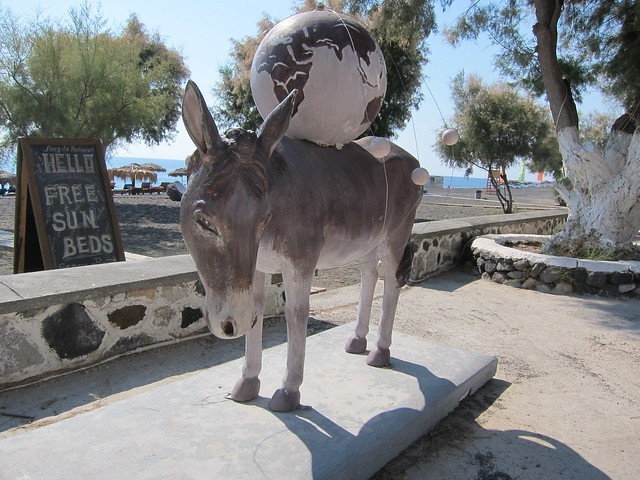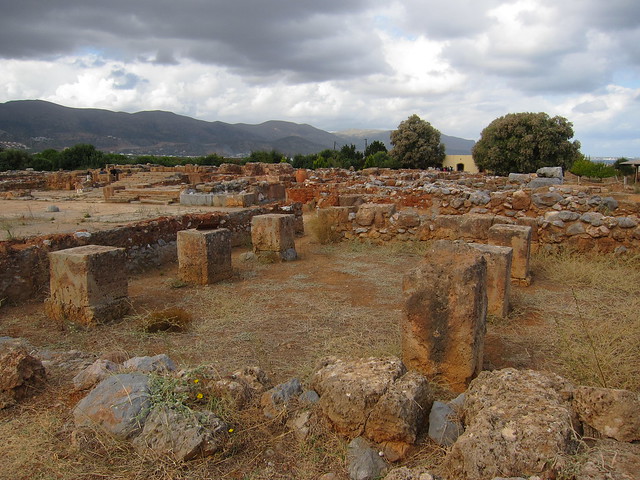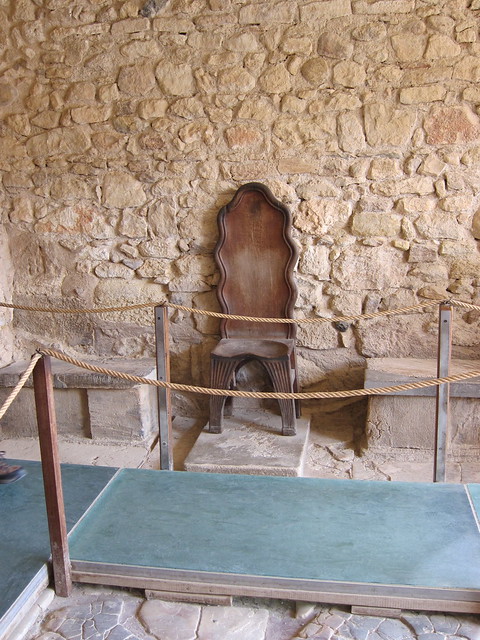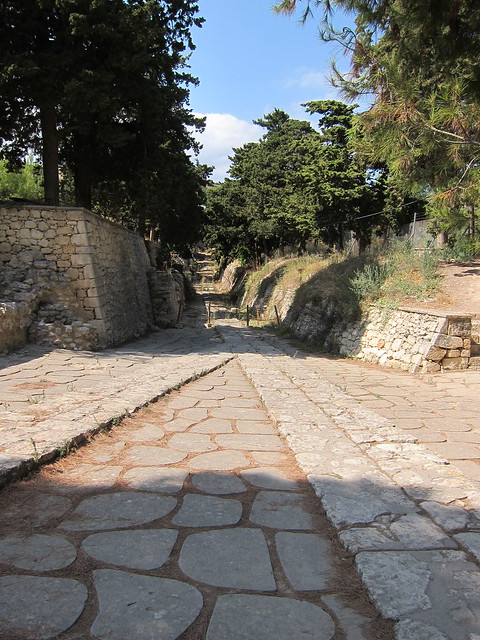We thought German towns couldn't get any cuter. Then we went to Monschau, a tiny, touristy town in the Eifel (a national park full of rolling hills and trees). Luckily, we came late enough in the "summer" that most of the tourists, except for the Belgians, were gone. Monschau is conveniently located about one hour by bus south-by-southeast away from our house, right on the Belgian border.
The first thing we did was go to Das Rote Haus (the Red House). Built in 1752, this was the home and office of a successful cloth merchant. Much of the original decor has been preserved. It was only 5 euros and, most importantly, it was well heated for us morning visitors. (We set a record by getting out of the house for one of our Saturday day trips by 9 AM!)
Self-supporting staircase, much slanted toward the center:

Silver tea service:

Us with a gruesome little sculpture:

Cal-colored room!

Ridiculous rainbow chandelier that looks as though it were made of little pieces of candy, hanging in the children's room:

There's a picture of the exterior of the Red House a little later. I bet you'll be able to pick it out. (Hint: the red is actually pretty pink.)
Monschau was in the middle of a three-day Halloween celebration. There were decorations up all over town, and they were doing face-painting for dressed-up kids in the market square. (Almost all the kids were either witches or ghosts. We saw one mummy and one vampire. I guess Germans are all about the classics.) Tyler and I saw this ghost and cracked up at the exact same time--German ghosts say BUH!

We'll have to go back to Monschau in a few weeks, after Halloween has been replaced by Christmas. It seems like a Christmas kind of town--not only do they have a seasonal Christmas market, they have a year-round Christmas store. It contained three stories stuffed with Christmas decorations for all tastes--there were cupcake ornaments, elegantly bedazzled balls, and corseted-female-figure ornaments.
Monschau is nestled among hills and clustered around two streams. As you can see, the fall colors were at their peak. Frankly, these pictures don't do it justice--we'd both stop every two minutes and gaze and sigh at the beautiful vistas.
Several buildings, like this hotel (Hotel Stern, in the middle), have private bridges leading to them. As you can see, the half-timbered houses here were among the most ornate, most crooked houses we've seen in Germany. And we've seen quite a few.
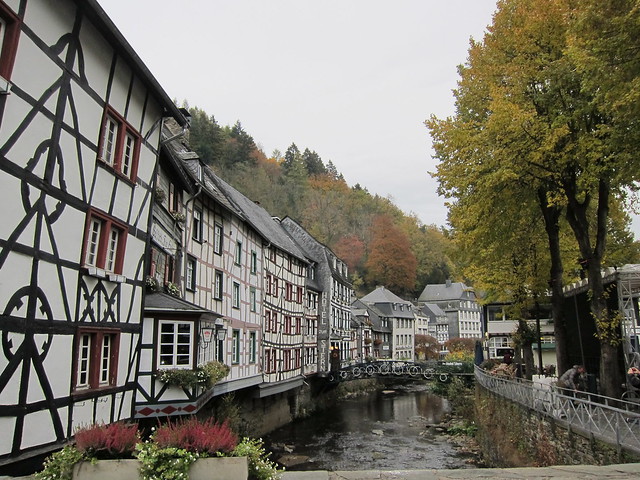

The town also boasts a fortress on a hill (left side):
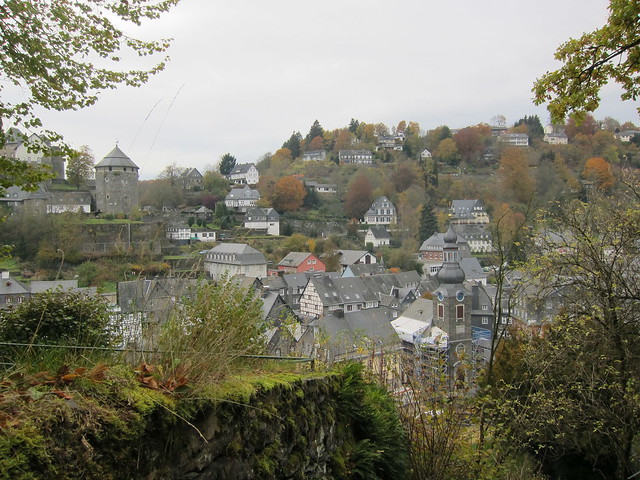
Das Rote Haus! Also ruins, on the opposite hill (top right):

The hills are full of beautiful natural rock outcroppings, along with man-made (though very old) stone steps and walls.

Tyler with the view:

After lunch we climbed up to get a better look at the ruins. The sun finally came out!

There wasn't much to see at the ruins, but we saw the city from another beautiful angle.

Here's another private bridge. I want to live in that house.

One of the highlights of the trip was having Old World food. We were very hungry after all our climbing around, so we started with roasted chestnuts in the market square:

This was our first time trying them. Delicious. They were extremely hot, but the flesh was surprisingly flavorful and had a great texture. We're hopeful that there will be lots of them in the Aachen Christmas Market. We also found a Belgian waffle shop. The waffles were fantastic. We had them for a snack to accompany out chestnuts. Then, since we had an hour before the bus back to Aachen came, we went back for one more. And a Coke. What a great day!
The first thing we did was go to Das Rote Haus (the Red House). Built in 1752, this was the home and office of a successful cloth merchant. Much of the original decor has been preserved. It was only 5 euros and, most importantly, it was well heated for us morning visitors. (We set a record by getting out of the house for one of our Saturday day trips by 9 AM!)
Self-supporting staircase, much slanted toward the center:

Silver tea service:

Us with a gruesome little sculpture:

Cal-colored room!

Ridiculous rainbow chandelier that looks as though it were made of little pieces of candy, hanging in the children's room:

There's a picture of the exterior of the Red House a little later. I bet you'll be able to pick it out. (Hint: the red is actually pretty pink.)
Monschau was in the middle of a three-day Halloween celebration. There were decorations up all over town, and they were doing face-painting for dressed-up kids in the market square. (Almost all the kids were either witches or ghosts. We saw one mummy and one vampire. I guess Germans are all about the classics.) Tyler and I saw this ghost and cracked up at the exact same time--German ghosts say BUH!

We'll have to go back to Monschau in a few weeks, after Halloween has been replaced by Christmas. It seems like a Christmas kind of town--not only do they have a seasonal Christmas market, they have a year-round Christmas store. It contained three stories stuffed with Christmas decorations for all tastes--there were cupcake ornaments, elegantly bedazzled balls, and corseted-female-figure ornaments.
Monschau is nestled among hills and clustered around two streams. As you can see, the fall colors were at their peak. Frankly, these pictures don't do it justice--we'd both stop every two minutes and gaze and sigh at the beautiful vistas.
Several buildings, like this hotel (Hotel Stern, in the middle), have private bridges leading to them. As you can see, the half-timbered houses here were among the most ornate, most crooked houses we've seen in Germany. And we've seen quite a few.


The town also boasts a fortress on a hill (left side):

Das Rote Haus! Also ruins, on the opposite hill (top right):

The hills are full of beautiful natural rock outcroppings, along with man-made (though very old) stone steps and walls.

Tyler with the view:

After lunch we climbed up to get a better look at the ruins. The sun finally came out!

There wasn't much to see at the ruins, but we saw the city from another beautiful angle.

Here's another private bridge. I want to live in that house.

One of the highlights of the trip was having Old World food. We were very hungry after all our climbing around, so we started with roasted chestnuts in the market square:

This was our first time trying them. Delicious. They were extremely hot, but the flesh was surprisingly flavorful and had a great texture. We're hopeful that there will be lots of them in the Aachen Christmas Market. We also found a Belgian waffle shop. The waffles were fantastic. We had them for a snack to accompany out chestnuts. Then, since we had an hour before the bus back to Aachen came, we went back for one more. And a Coke. What a great day!





















